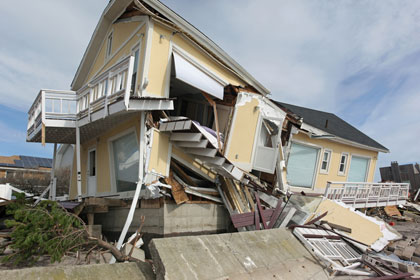Flood insurance surprises could hurt Sandy victims
And banks that aren't up on new program details
- |
- Written by Super User

Sandy devastated many homes and businesses. When this Rockaway Beach, N.Y., home is rebuilt--or replaced--will the owners build to the proper standards? With federal flood remapping underway, this is a critical question for borrower, builder, and banker. Photo credit: SVLuma /Shutterstock.com
| For more Sandy stories; articles to help your bank with flood insurance compliance; and helpful ABA links, go to our dedicated Sandy page. | ||
Something of a sleeper has been pending since July 6, 2012, in the flood insurance area. That's when the Biggert-Waters Flood Insurance Reform and Modernization Act was signed. Many questions regarding effective dates and regulatory implementation have yet to be resolved.
Of particular significance are pending increases to flood insurance premiums to reflect full flood risk of an insured building and the phase-out of many federal flood insurance subsidies.
"No one has connected the dots between the increased premiums, the loss of grandfathering, and bank safety-and-soundness concerns," explains Virginia O'Neill, senior counsel. And, coming on the heels of Hurricane Sandy, this is of immediate interest in the Northeast.
In brief, the problem here is one of critical information not feeding back into the post-storm cleanup.
First, Biggert-Waters will phase out existing subsidies for second homes, commercial properties, and "severe repetitive loss properties." Subsidies will be phased out at a rate of 25% per year until insurance premiums reflect the full flood risk of an insured building. In addition, for all property types, subsidies will be eliminated immediately upon a change of ownership or a policy lapse.
Second, Biggert-Waters will end "grandfathering." Previously, premiums could be calculated using the latest flood map requirements or the map in place at the time of construction, whichever was in the owner's advantage. Once rated by zone and elevation, those map conditions could be used to calculate future premiums, even if the zone or base flood elevation was changed in a later map. Beginning in 2014, all buildings will be rated using the latest maps. When the maps change, the rate increases will be phased in at each policy renewal, over the next five years at a rate of 20% per year. To illustrate the potential impact, the Federal Emergency Management Agency (FEMA) explains that a homeowner currently paying $1,500 a year for a $250,000 policy might find himself owing $9,500 or more once the new premium charges fully phase in.
"We are concerned that a lot of people who may already be struggling to pay their mortgage will be in trouble," says O'Neill.
"Eventually just about everyone's going to start seeing increases," she adds, "and nobody seems to recognize and to begin planning for this."
For hurricane victims, the news is worse. They and their builders and lenders may be making plans to rebuild to current flood map requirements without realizing that FEMA is in the process of re-mapping the New Jersey and New York coasts. That means that they are building anew to dated information. As explained above, when the new maps are adopted, nonconforming construction will be subject to severe premium hikes.
|
FEMA flyer helps make point to customers Does your bank have customers impacted by Sandy or other recent flood-related disasters? A handy flyer from the Federal Emergency Management Agency, Rebuilding After Sandy: Safer And Stronger Pay Off, provides concrete examples that will help your customers rebuild appropriately. A more general brochure, Build Back Safer And Stronger: What You Need To Know, is also available. |
|||
"Let's say you are rebuilding now, and don't realize that you should be building on pylons," says O'Neill. "You're going to be really angry at your bank for not knowing that."
Even before maps are adopted by local communities, FEMA is making "advisory base flood elevation maps" available to the public that can be used as construction guidance. "We hope that bankers can help get the message out to affected customers that they should look for the new maps and build to their specifications."
Editor's Note: These post-Biggert-Waters flood insurance issues are still developing. As updates or new news become available, we will place it on this page.
ABA members can learn more about Biggert-Waters here.
ABA members can access the association's general flood insurance page here.
[This article was posted on January 3, 2013, on the website of Banking Exchange, www.bankingexchange.com, and is copyright 2013 by the American Bankers Association.]
Tagged under Risk Management,













